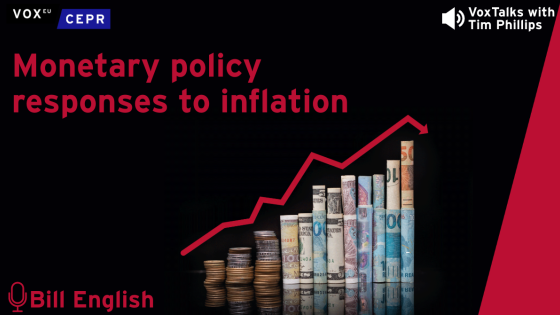Recently, leading academics and policymakers gathered at the London School of Economics to celebrate the 80th birthday of renowned central banker, Charles Goodhart. The celebration, as one would expect, gathered great thoughts from great thinkers – including some from Charles Goodhart (2018) himself. Over the last 60 years, he sees two periods of ‘consensus’ about the role and functions of central banks, and two periods of ‘uncertainty and disturbance’. The former periods include the Bretton Woods system of fixed exchange rates (1950s to early 1970s) and the Great Moderation with widespread inflation targeting (early 1990s to 2008). The latter periods include the post-Bretton Woods inflation, exchange rate, and debt troubles (1970s and 1980s) as well as the Global Crisis and subsequent low inflation recoveries (2008 and onwards).
Going forward, Goodhart has four ‘wishes’ for the next period of ‘consensus’:
- Universities need to deeply integrate macroeconomics and financial expertise, in order to prepare economists for work in central banks.
- Governments need to reform housing finance in order to avoid boom-bust cycles.
- The tax advantage of debt over equity needs to be removed.
- Banking regulation and supervision needs to focus on the incentives of senior managers (i.e. individuals, and in particular via remuneration practices), rather than on penalising financial institutions.
In a similar spirit, many leading policymakers and academics contributing to the project assessed central banks’ newly expanded monetary policies, their enhanced role in financial stability and supervision, the interactions between the two, and the implications for central banks’ role in the state and society at large. In this column we present a selection of the main arguments and contributors’ conclusions.
Monetary economics and policy
Starting with the core function of central banks, Mervyn King (2018) argues that modern monetary economics focuses on the real interest rate as the intertemporal price of a single available commodity. This risks neglecting parts of the monetary policy transmission mechanism that operate through the impact of quantities – recall central banks’ massive expansions of their balance sheets – on risk premia of various kinds. The current excessive emphasis on the effective lower bound of interest rates is a case in point. Discussing monetary policy in terms of conceptual models that do not ‘hide’ money would much reduce the scope for this and other biases.
In a similar vein, Hyun Shin (2018) notes that standard macroeconomic models still do not assign to banks the active balance-sheet management role that characterises their influence on the economy. Importantly, the bank lending channel of monetary policy transmission can only operate if banks are well capitalised, as otherwise credit would not increase in response to a reduction in interest rates. Moreover, a monetary loosening that brings policy rates into negative territory may not be effective in countries with significant deposit funding, because banks are reluctant to pass negative rates on to households. Shin concludes that bank capitalisation and other balance-sheet structures are equally important for monetary policy as they are for financial stability.
Don Kohn (2018) recommends that in their public guidance about the likely future course of monetary policy, central banks avoid focusing on dates, because this usually overstates knowledge about how the economy will develop over the next 1-2 years. Accordingly, the publication of median ‘dots’ of interest rate expectations by the members of the US Federal Open Market Committee should be discontinued. Instead, central banks’ forward guidance should emphasise more the economic conditions under which their policy would change, clarifying their reaction function.
Financial stability, regulatory policy, and their relationships with monetary policy
The experience with the Global Crisis has led to a greater focus on the macroprudential dimension of financial regulation and supervision. Dick Berner (2018) takes a snapshot of how macroprudential policy toolkits look to date. José Viñals et al. (2018) discuss the interplay between monetary, macroprudential, and microprudential policies in supporting financial stability. They conclude that each of them should have its own objectives and policy instruments to achieve them. Given their interdependencies, though, institutional arrangements need to be made to harness complementarities and reduce conflicts. These arrangements should give a strong role to central banks, including, notably, in the macroprudential area. This way the three policies can complement each other like ‘three wise men’ rather than be in each others’ way like ‘three cooks’ in one kitchen.
Starting from a novel literature, which suggests that a flexible exchange rate cannot ensure that monetary policy is able to control domestic inflation, Marcus Miller (2018) asks the question of whether home-country bank regulation and supervision can ensure domestic financial stability. He argues that with cross-border banking this can only succeed if macroprudential policies adequately address the pecuniary externalities in the build-up and unravelling of international financial cycles, particularly those operating through asset prices.
Focusing on microprudential regulation, Steve Cecchetti and Anil Kashyap (2018) study the interactions between different elements of the Basel III framework for banks. At its core arefour inequalities: a risk-weighted capital ratio, the (unweighted) leverage ratio, the liquidity coverage ratio, and the net stable funding ratio. They are all based on linear combinations of the same balance-sheet objects and the authors illustrate that they cannot bind at the same time. For example, of the two liquidity ratios, one will typically be slack. Cecchetti and Kashyap conclude that for different business models, different constraints will bind, potentially providing incentives for banks to become more similar. Moreover, supervisory stress tests may push banks towards regulatory constraints that are slack in tranquil times.
The scope of central banks and their role in the state and society
Paul Tucker (2018) argues that central banks cannot always be pristine but they should be as parsimonious as possible. Monetary policy unavoidably affects the size and structure of the consolidated public balance sheet, in particular for significant unconventional measures. This changes the state’s income and risk exposure, and therefore blurs the demarcation lines of fiscal policy. Since central bankers are unelected, they need to respect certain principles constraining their balance-sheet operations based on their statutory mandate, rather than "cast[ing] around for other good works".
In fact, Otmar Issing (2018) sees an institutional overburdening of central banks. As other policy authorities are unable to act, for example in the euro area, expectations on central banks become exaggerated (e.g. to compensate for the absence of structural growth policies with monetary policy) and their responsibilities extended (e.g. to banking supervision). The accumulation of powers leads to calls for limiting their independence. They are also bound to fail in meeting the expectations, in his view, putting further pressure on their independence and endangering price stability.
In the context of developing the European Economic and Monetary Union (EMU), Charles Wyplosz (2018) somehow goes in a different direction. Despite the ‘cartalist’ school’s view that the value of money comes from an act of a state (Goodhart 1998), he argues that the EMU can already function better by improving a number of institutions, rather than having to go all the way into a fiscal union. Wyplosz suggests that this would mean the ECB acting fully as lender of last resort in crises, further deepening its role as the single banking supervisor for the euro area and strengthening its Executive Board based on competency. While this would weaken the careful separation of monetary and fiscal policy in the EMU construction, it would bring the ECB closer to a ‘normal central bank’ (that can also backstop public debts). Other changes should include, in his view, fully decentralising fiscal policy to the national level, and reinstating the no-bailout clause.
Concluding remarks
One common thread across the contributions to this project is that almost a decade after the break-out of the Global Crisis, the economics profession has still not succeeded in properly integrating some main lessons into the standard curriculum. Views about which elements are missing differ between authors. For example, the core models still taught in macroeconomics:
- do not give enough of a role to money, which is rather ‘behind the scenes’ (King 2018, Peiris et al. 2018);
- have rudimentary (if any) representations of banks or financial sectors (Goodhart 2018, Peiris et al. 2018, Shin 2018); and
- do not characterise the macroeconomy as a ‘complex system’ (White 2018, Peiris et al. 2018).
Moreover, a number of contributors share the view that the changing fortunes of central banks – notably certain unconventional monetary policies and aspects of their greater role in financial stability – bring them closer to fiscal territory than previously was the case. Finally, several authors highlight intricacies for central banks associated with greater international monetary and financial interdependence. So far, neither development seems to have materially constrained central banks’ room for manoeuvre. But this could easily change in the future, in particular if calls for qualifying central banks’ independence are made.
Authors’ note: Any views expressed are summarised from the various authors’ book chapters and should not be interpreted as views of the ECB, the Eurosystem or China International Capital Corporation.
References
Berner, R (2018), “The macroprudential toolkit”, in The Changing Fortunes of Central Banking, Cambridge University Press.
Cecchetti, S and A Kashyap (2018), “What binds? Interactions between bank capital and liquidity regulations”, in The Changing Fortunes of Central Banking, Cambridge University Press.
Goodhart, C. (1998), “The two concepts of money: Implications for the analysis of optimal currency areas”, European Journal of Political Economy 14.
Goodhart, C (2018), “The changing fortunes of central banking”, in The Changing Fortunes of Central Banking, Cambridge University Press.
Hartmann, P, H Huang and D Schoenmaker (eds) (2018), The Changing Fortunes of Central Banking, Cambridge University Press.
Issing, O (2018), “Overburdened central banks: Can independence survive?”, in The Changing Fortunes of Central Banking, Cambridge University Press.
King, M (2018), “Money: How could economists do without it?”, in The Changing Fortunes of Central Banking, Cambridge University Press.
Kohn, D (2018), “Central bank talk about future monetary policy: Lessons from the crisis and beyond”, in The Changing Fortunes of Central Banking, Cambridge University Press.
Miller, M (2018), “Cross-border banking and monetary independence: Difficult partners”, in The Changing Fortunes of Central Banking, Cambridge University Press.
Peiris, U, D Tsomocos and A Vardoulakis (2018), “Liquidity, default and the interaction between monetary policy and financial stability”, in The Changing Fortunes of Central Banking, Cambridge University Press.
Shin, H (2018), “Bank capital and monetary policy transmission”, in The Changing Fortunes of Central Banking, Cambridge University Press.
Tucker, P (2018), “Pristine and parsimonious policy: Can central banks ever get back to it and why they should try”, in The Changing Fortunes of Central Banking, Cambridge University Press.
Viñals, J, T Mancini-Griffoli and E Nier (2018), “Three cooks or three wise men? The interplay between monetary, macroprudential and microprudential policies in supporting financial stability”, in The Changing Fortunes of Central Banking, Cambridge University Press.
White, W (2018), “Recognising the economy as a complex, adaptive system: Implications for central banks”, in The Changing Fortunes of Central Banking, Cambridge University Press.
Wyplosz, C (2018), “The case for (and requirements of) monetary unions’, in The Changing Fortunes of Central Banking, Cambridge University Press.







